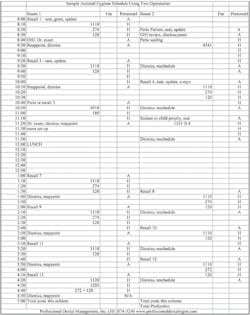Assisted hygiene
A coordinated effort in the hygiene operatory
by Dianne Glasscoe Watterson, RDH, BS, MBA
Traditional dental hygiene education teaches hygienists to work alone. Totally alone. Set up and turn over your own operatory, seat and dismiss your own patients, sterilize your own instruments, perform your own chartings, make your patient’s next appointment, and on and on. All solo. Many are the days when hygienists long for just a little help! There is an answer. It is called assisted hygiene.
The benefits of the dedicated hygiene assistant
Incorporating more efficient work practices is important in keeping the hygiene department profitable. Simply working faster and seeing more patients is not the answer. Working the traditional solo dental hygiene model is inefficient in that the hygienist has to spend a large part of his or her day performing tasks that could be done by an auxiliary.
For example, operatory teardown and setup takes about eight minutes per patient. If the hygienist sees an average of eight people each day, operatory turnover alone is one full hour, or one full hour that another patient could be seen.
Additionally, many tasks that should be a part of every dental hygiene visit are often omitted due to the lack of time. A good example is routine blood pressure screening. Although taking every patient’s blood pressure is part of the standard of care for all dental and dental hygiene students, many hygienists groan inwardly if they are asked to take blood pressures in private practice, primarily because of lack of time.
The all-important periodontal probing takes more than twice as long to do without an assistant to record probings as it does with an assistant. A hygienist working solo will need from 10 to 15 minutes to probe and enter the data, whereas a hygienist working with an assistant can perform a comprehensive six-point probing in about three to five minutes.
Meaningful conversation about home-care procedures and needed dentistry is another area that is often lacking. When time is short, even necessary radiographs are omitted or postponed until the next visit.
Consider the most stressful part of a hygienist’s day: waiting for the doctor to do the hygiene examination. How many times have you summoned the doctor for an exam, only to be kept waiting anywhere from 10 to 30 minutes? How many times have you paced the floor in the hallway while you wait, knowing that your next patient is already there? How many times have you fumed inwardly over the doctor wrecking your schedule? Just reading this may give you a stress knot in your neck!
The answer is assisted hygiene. How would you like it if you always had someone to help you do those periodontal chartings? How would you like it if you had someone to help you with room turnover/setup? And best of all, how would you like it if you never had to wait on the doctor again? Sounds like dental hygiene heaven, right?
False perceptions
Several years ago, someone came up with the scary phrase “accelerated hygiene,” which conjures up unpleasant images of a frenetic pace with the hygienist running from room to room like her lab coat is on fire. This perception is the reason why the mere mention of assisted hygiene causes some hygienists to recoil in fear. The very word accelerated means everything is suddenly thrust into high gear and moving faster. When we speed up in order to cram more patients on the schedule, quality of care issues are sure to surface.
Assisted hygiene is NOT accelerated hygiene. Speed is not the issue. The primary difference is that with assisted hygiene, many of the tasks that occur during the appointment are performed by a qualified assistant. There is a shifting of duties. Here is a list of procedures that commonly occur during a typical hygiene appointment:
1. Set up operatory
2. Review patient record
3. Seat patient and greet patient
4. Take blood pressure
5. Review medical history
6. Oral cancer screening and head and neck exam
7. Expose any necessary radiographs
8. Inquire about dental concerns
9. Give plaque control and oral hygiene instructions
10. Discuss dental needs
11. Do periodontal charting
12. Perform prophylaxis
13. Signal and wait for doctor
14. Dispense oral hygiene aids
15. Identify areas of caries or other pathology
16. Relate concerns to doctor
17. Make patient’s next appointment
18. Document in the patient’s chart (computer) all observations, patient comments, and future treatment recommended
19. Dismiss patient
20. Perform aseptic techniques in operatory, prepare instruments for sterilization
21. Set up operatory for next patient
If we look carefully at these 21 tasks, it is easy to identify certain ones that could be delegated to a qualified assistant. Of all the tasks listed, only #’s 2, 6, 8, 10, 11, 12, and 15 require a dental hygienist. Yet hygienists spend vast amounts of valuable time performing tasks that could be delegated.
A true assisted model in hygiene works much like many dentists work by rotating between operatories. While the assistant is preparing the first operatory, the hygienist is in the second operatory seeing a patient. The dental assistant would not necessarily have to be in the operatory with the hygienist, but should be available as needed. The assistant and hygienist would need to be together to record examination findings or periodontal probings, provide water evacuation during ultrasonic usage, or offer assistance with sealants. The dental assistant can expose any necessary radiographs and, in some instances, provide home-care instructions or polishing.
The doctor’s time, his or her most valuable asset, is spent doing things that are not delegable. Think of how productive a doctor would be if he or she had to process all the contaminated instruments, do all the operatory setup or teardown, seat and dismiss patients, etc. If the doctor performed all those tasks, productivity would be greatly reduced. The same is true for hygienists.
Prerequisites for the assisted model success
There are five prerequisites for assisted hygiene to work. First, there must be two operatories that are equally equipped with power scalers, instruments, and everything else needed to treat patients. Second, the assistant must be dedicated to work with the hygienist only on those assisted days. She cannot be shared, except if downtime occurs. Nothing will sabotage assisted hygiene faster than when the doctor hires an additional assistant and expects that person to help the doctor and hygienist simultaneously. Third, the assistant must be organized and have a thorough understanding of what her job is. Fourth, the hygienist must see the assistant as her strong right arm and not her “flunky.” No egos are allowed! Finally, the scheduling coordinator must understand how to schedule two rooms correctly. The schedule must be controlled and not overbooked.
How many patients can a hygienist comfortably see in an 8 a.m. to 5 p.m. day in an assisted model? The traditional solo model has hygienists seeing approximately one patient per hour; i.e., seven to eight patients per day. It is easy to increase to 12 to 13 patients per day with an assistant, which brings us to productivity. (See sample assisted schedule.)
Productivity with the assisted model
Let’s look at an example of average productivity of a hygienist working with and without an assistant.
Hygienist without an assistant
Assume one patient per hour and a 32-hour week, three cancellations, hourly pay at $30 per hour
Average cost of dental hygiene appointment – $150 (including doctor exam)
| 32 patients x $150 = | $4,800 |
| Subtract 3 cancellations | ($450) |
| Total | $4,350 |
| Subtract salary | ($960) |
| Subtract benefits (20%) | ($192) |
| Gross profit | $3,198 |
Hygienist with an assistant
Assume one patient per 40 minutes, 32-hour week, four cancellations. Assistant’s salary is $12 per hour
| 48 patients x $150 = | $7,200 |
| Subtract 4 cancellations | ($600) |
| Total | $6,600 |
| Subtract hygienist salary | ($960) |
| Subtract assistant salary | ($384) |
| Subtract benefits (20%) | ($268) |
| Gross profit | $4,988 |
| Productivity | $4,988 | |
| -$3,198 | ||
| $1,790 | per week x 50 weeks worked in a year | |
| $89,500 | ||
| Extra potential profit with assisted hygiene | ||
Advantages of assisted hygiene
Assisted hygiene is a much more pleasurable way to practice. Scheduled correctly, the hygienist can see 12 to 13 patients in an 8:00 to 5:00 day and be less tired at the end of the day than seeing seven to eight patients in a solo model. Productivity can increase anywhere from 33% to 50% with an assisted model. Most reasonable doctors are willing to share the increase in profit with increased pay, often with a bonus incentive over a set production goal. Even if the doctor didn’t pay any higher wages, practicing with a dedicated assistant is far superior to working solo.
Dental hygiene utopia
If we could design the perfect hygiene environment it would be like this:
- You never have to wait on the doctor to check your patient.
- You never have to clean up or set up your operatory.
- Someone takes the necessary radiographs for your patients.
- Someone is always available to help with periodontal chartings, suctioning, and assisting with sealant procedures.
- You never have to schedule continuing care appointments or dismiss your patient, because someone else does that.
That is a picture of the assisted model of hygiene. Hygienists who work with assistants report that doing hygiene procedures is more enjoyable than working solo. Additionally, one of the biggest time wasters — waiting on the doctor for a hygiene exam — is eliminated. The hygienist can move on to the next patient while the assistant waits with the patient for the doctor to do the exam. If all the prerequisites are in place, you will find the workday more satisfying, less stressful, and less tiring than when you worked solo.
Careful planning and appropriate implementation of the assisted hygiene model can open a whole new world of opportunity in the practice. Having a dedicated hygiene assistant allows the hygienist to see more patients, provide better care, and work more efficiently. It is an especially attractive option for areas where shortages of qualified hygienists exist. Patients often perceive a higher level of service when they are not left in the operatory alone. Time with the patient can be used to the fullest by providing more one-on-one contact with members of the dental team. Assisted hygiene is a triple winner for the patient, the hygienist, and the practice!
Best wishes,
Dianne
Dianne Glasscoe Watterson, RDH, BS, MBA, is a professional speaker, writer, and consultant to dental practices across the United States. She is CEO of Professional Dental Management, based in Frederick, Md. To contact Glasscoe Watterson for speaking or consulting, call (301) 874-5240 or email [email protected]. Visit her Web site at www.professionaldentalmgmt.com.
Past RDH Issues


